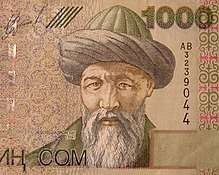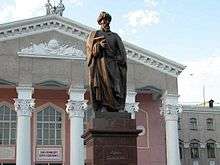Yūsuf Balasaguni
Yusuf Khass Hajib Balasaguni (Arabic: يوسف خاصّ حاجب, Yūsuf Khāṣṣ Ḥājib Balasağuni; Kazakh: Жүсіп Баласағұни; Uyghur: يۈسۈپ خاس ھاجىپ ; Kyrgyz: Жусуп Баласагын) was an 11th-century Central Asian Turkic poet, statesman, vizier and philosopher from the city of Balasaghun, the capital of the Kara-Khanid Khanate in modern-day Kyrgyzstan. He wrote the Kutadgu Bilig and most of what is known about him, comes from his own writings in this work. He is also referred to as Yūsuf Balasaguni, derived from his city of origin.
Yusuf Balasaguni | |
|---|---|
 As shown on the Kyrgyz 1000 som note | |
| Born | Yusuf c. 1019 |
| Died | 1077 (aged 57–58) |
| Nationality | Karakhanid |
| Other names | Khass Hajib (title) |
| Occupation | Philosopher, Vizier, Statesman |
| Known for | Kutadgu Bilig |
Background
His birthplace Balasagun was located at the Burana archaeological site near the present-day city of Tokmok in Northern Kyrgyzstan. His birthdate is estimated to be 1018[1] or 1019.[2] His father was one of the prominent and wealthy people of that time. The young poet received his primary education in his hometown. His main influences were Avicenna, Al-Farabi and Ferdowsi.
Kutadgu Bilig
He started to work on the Kutadgu Bilig (Middle Turkic: Wisdom of Royal Glory) in Balasagun and was about 50 years old when he completed it in Kashgar[3]. After presenting the completed work to the Karakhanid Hasan ibn Sulayman (father of Ali-Tegin) - Prince of Kashgar he was awarded the title Khāṣṣ Ḥājib, an honorific similar to "Privy Chamberlain" or "Chancellor". Some scholars suspect that the prologue to the Kutadgu Bilig, which is much more overtly Islamic than the rest of the text, was not written by Yūsuf, particularly the first prologue, which is in prose, unlike the rest of the text. He died and buried in Kashgar, 1077.
Memory
- A monument in Bishkek, Kyrgyzstan
- Kyrgyz National University was named after Yusuf Balasaguni in 2002.
- A number of streets in Kyrgyzstan bears his name.
- The image of Balasaguni is present on the banknote of the Kyrgyz national currency of 1000 soms. Also, the National Bank of Kyrgyzstan issued commemorative coins for the anniversary (1000 years since the birth) of the poet.
- Streets in Tashkent, Andijan, Samarkand in Uzbekistan bear the name Yusuf Hass Hajib.
- 2016 was declared "Yusuf Hass Hajib Year" by International Organization of Turkic Culture.[4]
Tomb of Yusuf Balasaguni
The mausoleum of the poet in Tainap, Kashgar was erected in 1865, but it was destroyed in 1972 during the Cultural Revolution and a school was built in its place.[5] After the death of Mao Zedong, the mausoleum was restored to its former location, and the school was transferred to another building. When restoring the mausoleum, several more unknown burials were discovered on its territory. The grave of Yusuf Balasaguni is decorated with inscriptions in Chinese, Arabic and Uyghur.
Gallery
 A Monument of Balasaguni outside Kyrgyz National University
A Monument of Balasaguni outside Kyrgyz National University Mausoleum in Kashgar that was constructed for his
Mausoleum in Kashgar that was constructed for his
alleged grave site Introduction Board at Mausoleum
Introduction Board at Mausoleum Portrait of Yusuf Khass Hajib at Mausoleum
Portrait of Yusuf Khass Hajib at Mausoleum Tomb of Yusuf Khass Hajib
Tomb of Yusuf Khass Hajib
References
- Dilâçar, Agop (1988). 900. [i.e. Dokuz yüzüncü] yıldönümü dolayısıyle Kutadgu bilig incelemesi (in Turkish). Türk Dil Kurumu. p. 21.
- Yūsuf (Khāṣṣ-Hājib); Arat, Reşit Rahmeti (1979). Kutadgu bilig (in Turkish). Türk Dil Kurumu. pp. XXIII.
- Devereux, Robert (1985). "Yūsuf Khāss Hājib, Wisdom of Royal Glory (Kutadgu Bilig): A Turko-Islamic Mirror for Princes, Robert Dankoff, trans., Publications of the Center for Middle Eastern Studies, No. 16 (Chicago: University of Chicago Press, 1983). Pp. 291". International Journal of Middle East Studies. 17 (4): 577–579. doi:10.1017/S002074380002972X. ISSN 1471-6380.
- "Yusuf Khas Hajib Year Opening Ceremony was Held in Istanbul | Türk Dünyası Belediyeler Birliği". Retrieved 2019-10-22.
- Millward, James A. (2010). Eurasian Crossroads: A History of Xinjiang. Hurst. p. 54. ISBN 9781849040679.